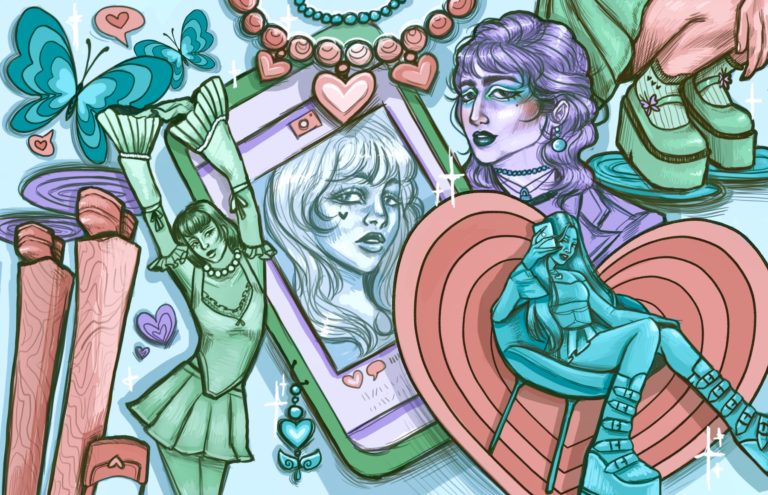

From leg warmers to mullets to the revival of low-rise jeans, those who follow fashion trends may have had a hard time keeping up with 2020. Stuck at home with nothing better to do, Gen Z packed what felt like five years of fashion evolution into just 12 months, incorporating style elements from the 1980s, 2000s and our very own bedrooms.
Several 2020 trends have obvious roots in the Y2K fashion movement. The most abrupt deviation from 2010s fashion was the return of low-waisted pants, which many swore they’d never revisit. While high-rise jeans aimed to elongate the leg, low-rise jeans accentuate the lower midriff, revealing a generation of forgotten lower back tattoos and “whale tails” — a peculiar nostalgia.
This peculiar nostalgia was a driving force in the return to Y2K fashion. Cooped up at home and finally old enough to pioneer fashion trends, members of Gen Z longed to replicate the fashion trends we saw in our childhoods. Accompanying the low-rise pant came the pleated miniskirt, a 2000s “it girl” staple. Other resurfaced Y2K trends include long shoulder bags, platform shoes, layering dresses and skirts over jeans, baby tees and slip dresses.
This return to the 2000s keeps in theme with the standard theory of the 20-year trend cycle — a phenomenon in which fashion trends resurface every two decades or so. But Y2K fashion suits the modern era in more ways than one. As the year 2000 approached, a conspiracy theory that computers would be unable to process numbers beyond 1999 circulated throughout popular culture and caused the mass phobia of a technology crash that would lead to the end of civilization. Fortunately, or unfortunately, the world did not end. Technology only got more expansive, the line between natural and artificial intelligence blurred and humans were regularly asked to prove their humanity to robots — thanks, Recaptcha.
Now, the world truly does seem to be ending. The pandemic forced us indoors, apocalypse-style. We watched a wave of fascism sweep the globe and we’re grappling with the reality of the climate crisis. Gen Z is reviving Y2K not only because we miss it, but because we’re reliving it. We wear our miniskirts and shoulder bags with a similar spirit of optimistic nihilism: The world is ending, so we might as well look cute.
It’s not all a repeat of 2000, though — 2020’s take on Y2K was met with a queer twist. The mullet and shag haircuts are Gen Z’s most apparent queer-coded changes to Y2K fashion. From Jane Fonda to Rob Lowe, these hairstyles have historically known no gender and have thus become symbols of style, confidence and queerness in 2020. Of course, not all those who rock a 2020 mullet are queer, but from Miley Cyrus to Barbie Ferreira, the look was pioneered by the LGBTQ+ community.
Other examples of queer-led quarantine trends include septum piercings, sweater vests and, of course, a general desire to stop catering to the male gaze; for example, women proudly wear five-inch Demonia platform shoes without fear of being taller than men. Furthermore, women and femmes have reclaimed the corset — an article of clothing that once symbolized misogynistic and unrealistic body standards now serves as a tool for anyone to embrace their femininity.
A possible cause of this surge in queer femme undertones is that, during quarantine, women and nonbinary folks began leading trends on TikTok. Instead of exclusively big fashion labels setting trends, Gen Z teens set trends from the comfort of their bedrooms. While the feminine fashion industry has historically been dominated by straight women and gay men, the grassroots nature of TikTok allows queer women to control their narrative.
Toward the middle of quarantine, a TikTok expressing the desire to “look feminine in the way men do” blew up. Thousands of women and nonbinary Gen Z-ers accepted the challenge, sporting androgynous yet feminine looks that said “I’m feminine” in a nonconforming way. This trend isn’t exclusive to any sexuality, but the notion of playing with masculinity and femininity, or simply straying from one’s traditional gender role, has queer elements. Of course, the queer community has been playing with gender for decades, but 2020 saw a breakthrough of queer-led feminine styles into mainstream fashion.
Women aren’t the only ones who took fashion inspiration from feminine queer communities — 2020 was arguably the year of the “femboy.” Over the course of quarantine, TikTok saw a growing number of men proudly paint their nails and wear skirts, dresses and other traditionally feminine articles of clothing. This trend hit its peak when Harry Styles famously wore a dress for his Vogue cover in November. Femininity was truly “in vogue” this year.
Reflecting today’s disembodied political arena, 2020 fashion combined the Y2K spirit with queer ingenuity. In a seemingly impossible stroke of gay, fashion-forward creativity, Gen Z found a way to pair the Joan Jett mullet with the Paris Hilton mini skirt. That’s hot.
Contact Piper Samuels at [email protected].